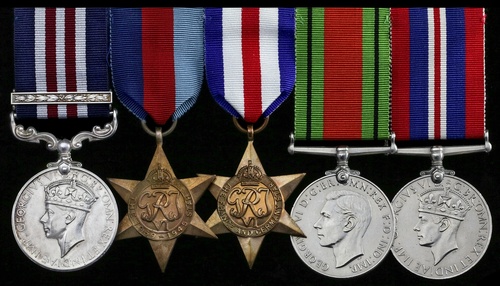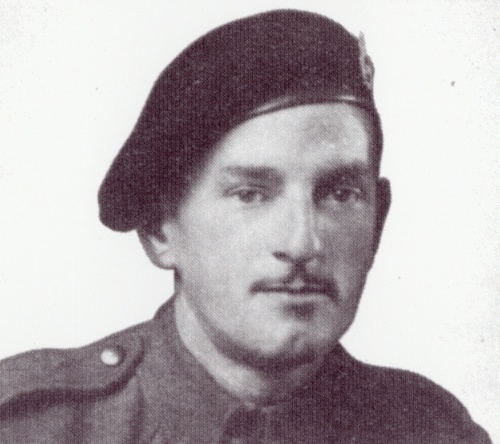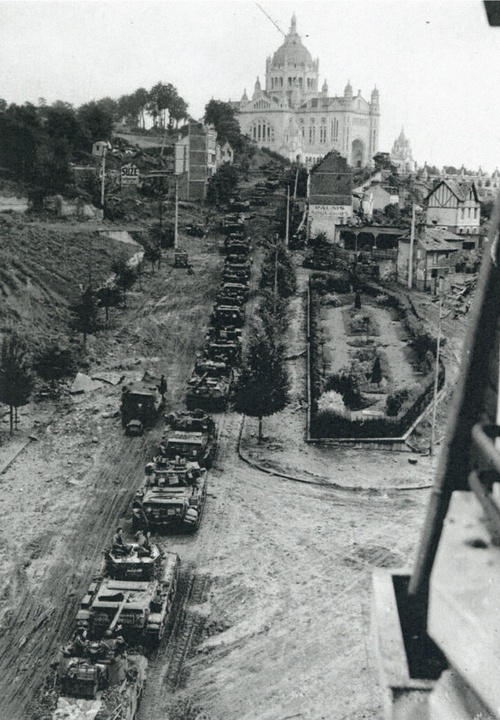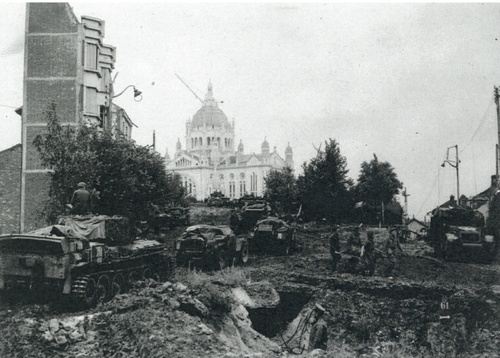Auction: 19002 - Orders, Decorations and Medals
Lot: 392
The outstanding and unique Second World War 'North-West Europe 1944' immediate M.M. and Bar group of five awarded to Squadron Sergeant-Major J. T. 'Paddy' Caulfield, 24th Lancers and 1st Royal Tank Regiment, a 'wild Irishman' and ex-waiter at Lyons Corner House, who refused to depart the scene of battle on being seriously wounded
Military Medal, G.VI.R., with Second Award Bar (7927891 Sjt. J, T. Caulfield. 24-L.); 1939-45 Star; France and Germany Star; Defence and War Medals 1939-45, nearly extremely fine (5)
M.M. London Gazette 19 October 1944. The original recommendation states:
'On 26th June 1944, Sergant Caulfield was commanding a 17-pounder Sherman at Tessel Wood. He was ordered to investigate and silence an anti-tank weapon which was firing at his Squadron's tanks and which could not be located.
He found five Panthers and with the assistance of another tank he destroyed two of them and forced the rest to take cover.
He was then ordered to assist a troop of Sherman 75mm's which could see some enemy tanks but was unable to engage them successfully. By moving from position to position he succeeded in destroying two Panthers and probably damaged others.
By the bold skilful handling of his tank this N.C.O. inflicted a heavy loss upon the enemy.'
Bar to M.M. London Gazette 1 March 1945. The original recommendation states:
'On 23 August 1944, Sergant Caulfield was in command of a Sherman 17-pounder tank operating in support of 1/5 Battalion, The Queen's (Royal West Surrey) Regiment east of Lisieux. The Infantry reported a Panther Tank approaching and Sergeant Caulfield was ordered to move and cover the road down which the Panther was coming. Sergeant Caulfield went right forward on foot beyond the Infantry to look for a good position for his tank and came under heavy Spandau fire while doing so.
He was wounded in the head but continued to command his tank. The Panther appeared in Sergeant Caulfield's sights but his gun misfired and he was hit in the suspension. He finally got off the round and the enemy tank withdrew. Sergeant Caulfield continued to fight his tank and to direct the infantry on to targets and refused to leave his tank until ordered to do so by his Troop Leader. He was finally carried away still demanding to be allowed to return to his tank.
This N.C.O.'s fighting spirit was a great example and encouragement to the infantry and possibly prevented a withdrawal. He undoubtedly saved many lives by remaining at his post and engaging the enemy's fire.'
John Thomas Caulfield - or 'Paddy' to his comrades - served with distinction with the 24th Lancers during the North-West Europe campaign. Having been raised in December 1940, they were active in the field over the nine weeks having landed on D-Day +1, before being disbanded without notice. Like many units raised for the rigours of the Second World War, they had an auspicious start, as referred to in the None had Lances - The Story of the 24th Lancers:
'[31 January 1941] Who were all these civilians in uniform? It would be tedious to list all 283 of them but they included a milkman and a publican, a company director, a general merchant and a timber importer, a butcher and a fishmonger, commercial travellers, clerks and local government officers, a barrister, a solicitor and a solicitor's clerk, a park keeper and a coal merchant, an estate agent, two building contractors and a cement worker, a medical student and a photographer, an insurance agent, a furrier, a hairdresser and a bus conductor, two bus drivers, a machine operator from The News of the World and a gents' outfitter. There came Sid Smith, the billiards champion, and from the musical world, Maurice Miles, the well-known orchestral conductor and Peter Barbirolli, the viola player, brother of the late Sir John. Finally there was one conscientious objector who had to be guarded night and day until he left us.
Some arrived in sports cars complete with golf clubs and much luggage. Others came with their basic necessities wrapped in brown paper parcel.
Many stand out in our memory but two must suffice.
There was Paddy Caulfield, a wild Irishman and a waiter at Lyons Corner House who had to use all his native blarney to excuse his arrival several day late but who, before the end of the war, rose to the dizzy heights of Squadron Sergeant-Major and in Normandy won the Military Medal with the Regiment and subsequently with the 1st R.T.R. won a Bar to that Medal.'
Deployed to Normandy on D-Day +1, Captain The Reverend Mark Green, M.C. takes up the story in his diary on 9 June:
'A hellish few days. I knew little about the big picture, but guessed it was the same on other parts of the invasion front. It was really a miracle that we were still in Normandy, and not smashed to bits and driven into the sea. We (the Armoured Brigade, including 24th Lancers, in support of 50th Northumbrian division) had been holding a high position identified on the map only as “Pt. 103”. But Point 103 became a poignant symbol for all of us. The more wooded part was about half a mile square, and it was here that we beat off attacks from the Panzer Lehr, a crack German tank division which had driven 90 miles from Chatres to get at us; also from the famous 12th SS Panzer (Hitler Jugend) Division, with their fanatically brave boys who counted it an honour to die for the Führer.’
It was during Operation 'Epsom', two weeks later, that Caulfield won his first Military Medal. During the fighting around Tessel, Caulfield served as a Tank Commander in the 4th Troop of 'A' Squadron. On 25 June they moved off from Les Hauts Vents at 2.45a.m. and pushed in the direction of Tessel Wood, with 'A' Squadron moving through the valley in support of the 4th Battalion, Lincolnshire Regiment. They advanced through thick fog, whilst a heavy artillery bombardment rained down. Having made it to Fontenay, Lieutenant 'Bob' Hart of 'A' Squadron ran into enemy tanks. None had Lances takes up the story:
'My Troop was sitting astride the Fontenay-Juvigny road facing east when the Commanding Officer of the Hallams came up to me and said that a Panther in the village was holding up his advance. I accordingly dismounted and went with him into the village where I saw this tank hidden by the wall of a house thus obscuring my view and preventing me from obtaining a good fire position. I went back to my tank and driving it into the village knocked down the wall which was hiding the Panther. At that moment, however, two more Panthers appeared just south of the road. I knocked one of them out and the other withdrew. Unfortunately, in the meantime, the original Panther had also withdrawn to a position behind some tree and I was unable to get a good shoot so I went back to my original position.'
Hart won a Military Cross, whilst the Colonel noted in his own diary that evening:
'We killed a lot of Huns.'
Caulfield would kill a good number more the following day. When snipers were found in the hedgerows around their positions, they were flushed out with machine-gun fire. 'A' Squadron was to use the day probing towards the villages of Le Manoir and Tesselbretteville with the 12th Battalion, King's Royal Rifle Corps. Due to the nature of the terrain, thick with trees, hedges and buildings, all of which seemed to bristle with hardened German troops willing to fight and die where they stood, the going was tough.
Having been disbanded in July 1944, the Regiment's honours and record of enemy armour destroyed is worthy of publication:
1x Distinguished Service Order
6x Military Cross
3x Military Medal
19 enemy tanks destroyed
2 Anti-tank guns destroyed
3 SP guns destroyed
5 half-tracked vehicles destroyed
5 armoured cars destroyed.
This at a cost of 42 killed in action in Normandy, with a further 98 wounded in the subsequent campaign.
Caulfield would add a Bar to his M.M. on attachment to the 1st Royal Tank Regiment. Whilst many German units were capitulating and retreating at pace, pockets of bitter resistance held up the advance. One such occasion was at Lisieux. Formed up around the Basilica of St. Theresa which surmounted the hill, German snipers littered the many balconies and alcoves of the church. Infantry had probed into the town and been thrown off, as recalled by Sergeant Boardman:
'As we drove into Lisieux the road was packed with infantrymen waiting to move forward. The 51st Highlanders were having to fight house to house, street by street and had to capture the Basilica which dominated the area.
As we approached the forward position the constant stream of stretcher-bearing Jeeps with badly injured troops from both sides was indication of the resistance being encountered. As our troop of three vehicles came up to the Queen's infantry, their young officer indicated the enemy positions. The platoon was in a single file and keeping close against a wall.
I cannot remember ever feeling more pity for them than I did on that occasion. As the Bren crew went forward they became instant casualties. The Piat crew took up the leading position. The platoon was soon either dead or wounded.'
Having been wounded in the head during these engagements to assist the 1/5th Battalion, The Queen's (Royal West Surrey) Regiment, Caulfield was withdrawn for medical treatment.
Sold together with copied full War Diary of the 24th Lancers (WO171/849), recommendations and extracts from None had Lances, including a portrait photograph of the recipient.
Subject to 20% VAT on Buyer’s Premium. For more information please view Terms and Conditions for Buyers.
Sold for
£10,000
Starting price
£5800











